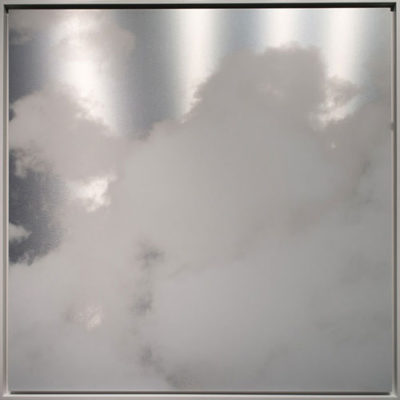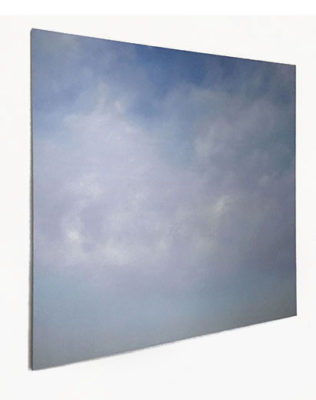by David M. Roth

The viewing experience, depending on how it’s staged, can sometimes be elusive. That is because the works that comprise the artist’s current series, Oborozuki (Moon Obscured by Clouds), reveal themselves only in indirect natural light and only from certain viewing angles. To see them without the distraction of glare, ask the gallerist to turn off the lights. Once extinguished, the details of the compositions come into view: Flat expanses of seemingly inscrutable white ink give way to multi-dimensional cloudscapes whose faintly tinted hues and shapes shift according to where you stand. Duchamp famously spoke about how the viewer 
Her 2016 show in this space, Atmosphere, featured paintings of shimmering ocean sunsets and moonrises, notable mainly for their seamless gradients and for how radical shifts in color could be summoned by simply moving around the room. Those same dynamics remain in effect, except now the compositions are flatter and more complex. November Kumo (Cloud) 3 is emblematic of the series. Straight on, the work appears to show an opaque cloudbank as if seen from the vantage of an airplane. Stand to one side and the clouds part, opening up several different vistas, each a unique “composition.” The forms reveal no trace of the artist’s hand. Unlike Ando’s previous cloud paintings, in which shapes seemed to leap off panels like billowing cotton balls, these feel closer to vaporous exhalations. Colors also undergo transformations; they move from pure whites and dirty grays to sky blue and dark purple, with many gradations in between, depending, again, on your viewing angle.
Not everything in the exhibition works as effectively or as seductively. Three circular works on paper, made of gold paint and silver leaf, fall flat, while the largest painting, measuring 48 x 96 inches, suffers from a urethane coating, nullifying the optical properties that make other works so enthralling. In the main, Oborozuki restates the epistemological question that rests at the heart of Ando’s practice: What do we know and how do we know it? While certain parts of that
For Ando, a practicing Buddhist, that injunction dovetails nicely with a central tenet of her religion, the one that calls for the puncturing illusions, for pulling back the veil of what ancient practitioners called maya or deception. At a time when deceit reigns supreme, an art that asks us to look beyond appearances suddenly assumes fresh and unexpected relevance, inviting political analogies the artist probably never intended when she began using metallurgy to advance ideas about time, ephemerality and infinity.
# # #
Miya Ando: Oborozuki (Moon Obscured by Clouds) @ Nancy Toomey Fine Art through February 22, 2018.